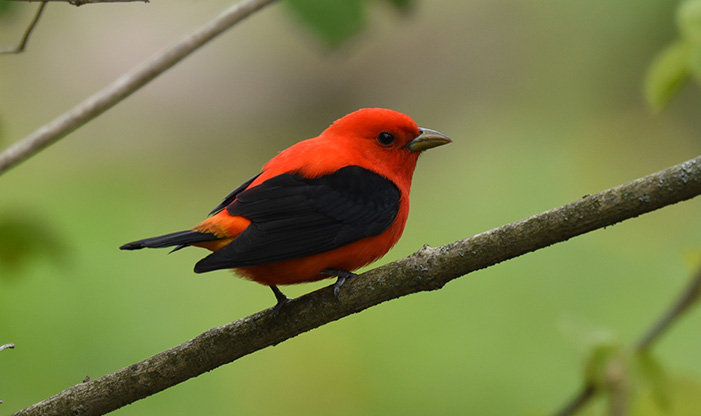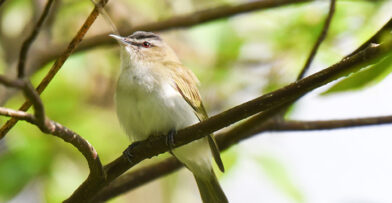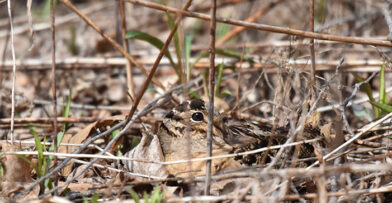Our Bird Profile series highlights a species that is migrating through, breeding, or is a year-round resident of Wisconsin that can be found at Schlitz Audubon or in your backyard.
Name
Scarlet Tanager, Piranga Olivacea
Basic Description & Appearance
The Scarlet Tanager is a flamboyant-looking, medium-size songbird comparable in size to a Baltimore Oriole, measuring 16-17 cm. The breeding male displays bright red plumage and tail with jet black wings and a light-colored bill. This species is sexually dimorphic and dichromatic, with males displaying different coloration than females. The female is olive with olive-brown wings, green tail, and olive-yellow underside and eyelids. The adult non-breeding male resembles the female but is brighter. The female and immature Scarlet Tanager can be confused with the female and immature Summer Tanager because of their similarity in appearance, though they are easily distinguished by their different calls. During molting season, male Scarlet Tanagers become splotchy orange, red, and yellow in coloration, displaying a lot of variation as new feathers come in.
Vocalization
This bird species is heard making its robin-like Chip-Churr calls and is often more easily found by sound than by sight due to its secretive nature.
Habitat & Nesting
The Scarlet Tanager breeds in the eastern US and southeastern Canada, with their range coinciding with that of the Eastern Deciduous Forest Biome. The bird utilizes overwintering territories in southeastern US, Central America, and the northwest regions of South America, mostly within primary and high-second growth forests and forest edges.
This species is monogamous and very territorial, preferring mature deciduous forests populated with oak trees. These woodlands need to have larger, unfragmented forest areas of at least 25 acres for the birds to maintain a viable population.
Breeding begins in late April to early May. Nest building begins within about a week after courtship, with the nest built among the leaves at a site of the female’s choosing, though in an area the male used for courtship. Eggs are laid within two days of nest completion, incubation lasts for about 14 days, and then young leave the nest within 15 days.
Diet & Foraging
During the breeding season, the Scarlet Tanager eats mainly insects, including ants, moths, butterflies, spiders, and more. They usually search for the insects high in the canopy or on tree trunks by probing the bark. They are known to grab insects from leaves, bark, and flowers by hovering or perching (gleaning) over a branch. They also engage in hawking, catching flying insects in mid-air. Scarlet Tanagers will forage on the ground for insects, also eating berries, tender buds, and sometimes consuming nectar.
When & Where to Find at Schlitz Audubon
Sightings of Scarlet Tanagers at the Center peak in May during spring migration and are usually spotted (or heard) in our forest habitats.
Other Fun Facts
- The Scarlet Tanager is in the Family Cardinalidae, which is the same family as the Northern Cardinal.
- They are occasionally seen drinking from the banks of streams, puddles, and occasionally from bird baths.
- On their wintering grounds in central and South America, Scarlet Tanagers form flocks with flycatchers, antbirds, woodcreepers, and resident tropical tanagers.


